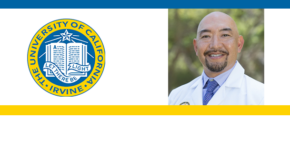 COVID-19 has been a learning experience for everyone, including clinicians.
COVID-19 has been a learning experience for everyone, including clinicians.
Jonathan Watanabe, professor of clinical pharmacy at the University of California, Irvine, details treating a new disease on the fly.
Professor Watanabe is a pharmacist, health economist, and outcomes researcher. He serves as a Member of the National Academies of Sciences, Engineering, and Medicine (NASEM) Forum on Drug, Discovery, Development, and Translation. In this capacity, Professor Watanabe has been involved in methods development for pragmatic clinical trials through the FDA-sponsored Real-World Evidence Series and serves on the steering committee for the Drug Research Development in Older Adults Workshop. Professor Watanabe applies real-world data to develop policy solutions to improve patient care, bolster population-health, and reduce medical costs. He was a contributor to the NASEM report Making Medicines Affordable: a National Imperative. His research on health implications of non-optimized medication regimens has been cited in multiple successful state legislative efforts to bolster patient-centered care and medication management, and he has testified before the California Senate Health Panel regarding value of comprehensive medication management services to bolster the health and wellness of Californians enrolled in Medicaid. He is a consultant to the California Health Benefits Review Program of the California State Legislature and served on the Advisory Group on Pain Assessment and Management in Long-Term Care Settings for the Joint Commissions. He is currently appointed to the NASEM committee on Implications of Discarded Weight-Based Medications mandated funded by the Centers for Medicare and Medicaid Services. Dr. Watanabe was the first recipient of the University of Washington/Allergan Global Health Economics and Outcomes Research Fellowship. He received his BS from the University of Washington, his PharmD from the University of Southern California, and his MS and PhD from the University of Washington Comparative Health Outcomes, Policy, and Economics (CHOICE) Institute. He is past recipient of the University of Washington Distinguished Alumnae in Pharmaceutical Science and Research award. He is a past National Academy of Medicine (NAM) Anniversary Fellow in Pharmacy sponsored by the American Association of Colleges of Pharmacy and the American College of Clinical Pharmacy. He currently serves as a Scholar in the NAM Emerging Leaders in Health and Medicine Program and serves as a Distinguished Fellow of the Get the Medications Right Institute. He is a Board-Certified Geriatric Pharmacist (BCGP).
COVID-19 Medications
Before the name “COVID-19” came into common use in the early days of the epidemic, we referred to SARS CoV-2 as the “novel coronavirus,” because it was, indeed, new to all of us.
As the disease took hold in early 2020, the numbers of patients hospitalized with COVID-19 climbed at our affiliated five medical centers, eventually totaling well over 22,000 people that tested positive in 2020.
Early in the Pandemic, clinicians sought the most effective treatments to help those in need, but little was known about what worked to treat sick patients—many health care providers stated they felt like they were ‘flying blind.’
In this study, our interdisciplinary team of a clinical pharmacist, infectious disease physicians, and statisticians tracked medications used to treat patients hospitalized with COVID-19 in a state-wide, academic medical center database. Graphs in the paper shows utilization patterns of 10 different drugs given over the course of 2020.
One of the most dramatic shifts we plotted was for hydroxychloroquine, an antimicrobial touted as highly effective by the White House around that time. It was given to more than 70 percent of patients in mid-March, but that usage cratered by early Summer, and never picked up after that. This roughly coincided with evidence from strong studies showing hydroxychloroquine had no benefit.
The opposite can be seen with dexamethasone, given to only 1.4 percent of patients per day at in March but grew to 67.5 percent by the end of December. The inexpensive generic corticosteroid was found to be effective in large trials of patients in the United Kingdom. U.S.-based clinicians applied that knowledge, as our plots showed clearly.
This big data statistical analysis, measuring drug utilization patterns for COVID-19 patients, we observed the rapid adjustments clinicians made based on the flow of evidence that led to the increased survival patterns we saw nationally as treatment evolved. It attests to the value of evidence-based practice that may help us prevail in future pandemics.

Comments
One response to “Jonathan Watanabe, University of California, Irvine – COVID-19 Medications”